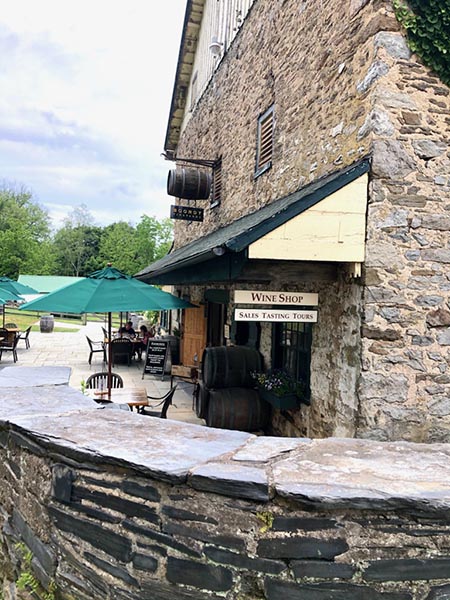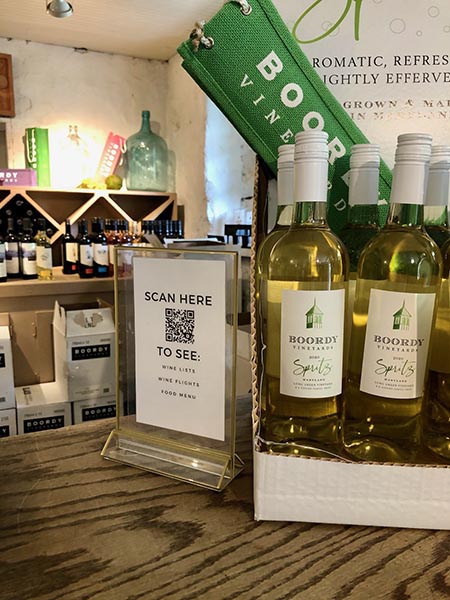I’ve spent so much time writing about QR codes as an opportunity that I hadn’t really thought about them as a threat. But if you’re serving the wine, dining, or similar industries, they might bite into your sales. This really hit me after walking into Boordy Vineyards (Hydes, Md.), near where we live.

I walked through the outdoor seating area, where people were taking wine “flights” or paid tastings of various selections of wines. Inside was the sales counter and a plaque with a QR code that took customers to the wine listings, wine flight options, dining menu, and information on tours. James Prichard, director of winery sales, was out and about in the sales area. I asked how many people who came in actually scanned the QR Code. He looked at me directly and said, “All of them.” The reason, it turns out, is that the winery no longer uses printed menus. All of its customers access the menu via the QR Code each time they arrive.

Why no more printed menus? There are a few reasons—listed in no particular order.
- Wind damage. Since COVID-19, Prichard says, all of Boordy’s seating has moved outdoors. Printed menus are a pain because they get picked up by the wind and fly away. That’s money out the proverbial window for Boordy and an inconvenience for customers.
- Customer preference for paperless. Nearly all (95%) of the vineyard’s customers are less than 60 years old. This demographic, Prichard explains, is environmentally conscious and prefers not having printed menus because they see them as wasteful. Even the “over 60” patrons tend to be more environmentally conscious than the average consumer.
- Ease of change. The vineyard has 30 wines that it makes on the premises, and it uses 15 of them in its three “flight” categories. The wine selections change monthly. Continually printing updated menus would be costly, and reprinting the menus infrequently pretty much guarantees that at least some portion of the menu will be inaccurate much of the time. Now, via the QR code, all Boordy has to do is change the text on the web page on the back end of the QR code. When customers scan the code, they get the updated flight selections automatically.
- Better customer experience. All of this results in better customer service. Not just so customers can stay on top of frequently changing wine flights, but also because there are times that, as a local winery, Boordy may not have certain products in stock. Rather than have to continually tell people what is and isn’t available, Boordy updates the URL on the back end of the QR code so that when customers arrive, they are only selecting from an updated list.
Even as the pandemic restrictions lift and customers can start moving inside again (Maryland was one of the first states to fully reopen and lift the mask mandate based on extremely high vaccination rates and low infection, hospitalization, and positivity rates), Boordy plans to keep its mobile-only menu because of all of the benefits, including cost savings and better customer experience. While this is great for Boordy, it means a permanent loss of printed menus for the shop doing Boordy’s printing.
So while I still love QR codes and believe in the benefits for many applications, as with pretty much anything in life, there is also a flip side. For printers in certain market verticals, this is one of them.










Discussion
By Tom Crouser on Jun 23, 2021
Noticed this same thing at "Burger Up" in Nashville which is not upscale, but a youthful sit down burger joint in April 2021. Also with three other restaurants during my trip there. So, it's just not the classier places replacing menus with QR codes.
By Gregory Smith on Jun 23, 2021
If QR menus are the future, I hate the future. I find them almost always poorly executed, built for web instead of mobile so they don't scale to your device, so one is constantly pinching and zooming, scrolling side to side. It's also hard for me - and most people I'd gather - to truly sort it out in the brain as to what the selections are that I've previously viewed due to the brains way of mapping stuff out. Give me a printed menu any day. I own a brewery as well as a printing company - so I can print my daily menus no problem.
By Dave Hultin on Jun 23, 2021
There's a lesson to be learned here. Printers need to be experts at delivering the message, regardless of the medium. Is there an opportunity for someone to go to James and say, "Your printed menus aren't being used any longer, but are you asking for the contact info of scanning that QR code? Will you follow up with postcards and newsletters to keep them coming back?"
As Gregory Smith mentioned in the previous comment, many QR code presentations are poorly executed. Is there an opportunity to help improve the execution? (And introduce other opportunities for print as part of the bigger picture?)
By Robert Godwin on Jun 23, 2021
QR codes new? The future? Oh please! They are the same age as Photoshop which makes QR about 40 years old. As for poorly executed QR hand-offs to a web site, how many poorly executed print jobs go out every day...
I thought the pandemic would have changed enough minds about technology not to hear stories based in unfounded fear. If you lose work to a QR code because the market shifted from a print channel to a digital channel (menu cum website), then make the changes you need. Print the sign with QR code on it (see the photo from the article).
Print is anything you print on. Add those products, keep your finger on the pulse of the market. Don't stand behind a counter waiting for the next job. Go out and look at what the world is doing and ask why. Once you take action on the answers you get, you will have all the business you can handle.
By Dave Hultin on Jun 23, 2021
Heidi, this one has caught my interest, I'd like to follow the trial. Do you have the QR code (or it's destination) for the menu you referenced? I'd like to see what the QR trail looks like if you're willing to share...
By Gary Parish on Jun 23, 2021
We are the patent holders of the most advanced 2D barcode in the world, HD Barcode. We keep it both private and secure and why Boordy Vineyards should be careful using a public QR code that anyone can create and send to a phishing site. Let's say I have less than honest intentions. I go into the store and grab a picture image of the code and page, including the fonts used. I read the code and grab screenshots from that website. From there, I can make a fake QR Code (as a consumer, you can't tell the difference) that now takes you to a site where everything exactly looks like the authentic site, except I am now giving away a free bottle of that wine. All you have to do is pay $3.99 for shipping and handling. Please provide me your credit or debit card, THANKS....
Not only do I have your card info, but your phone info as well. How hard would it be for me to slide a new sheet into the holder at the store?
In an article by Kaspersky "Are QR codes safe?
Attackers can embed malicious URLs containing custom malware into a QR code which could then exfiltrate data from a mobile device when scanned. It is also possible to embed a malicious URL into a QR code that directs to a phishing site, where unsuspecting users could disclose personal or financial information.
Make sure that the code is either secure or printed as part of the package.
By Gregory Smith on Jun 23, 2021
I don't know anyone that said QR codes are new, I simply said if the QR codes menus I've seen are the future of restaurant menus then it's a stupid future. Now excuse me, I have to get back behind my little counter and cower in fear from the FUTURE...
By Robert Godwin on Jun 23, 2021
Put the Delorean in reverse, the future was forty years ago. And, you're going to need a bigger counter. Oh fiddly dee, I'll think about the future tomorrow.
Please only respond with modified movie quotes.
By Heidi Tolliver-Walker on Jun 23, 2021
@Dave Hutlin. I can crop the original image down to just the QR Code, and it does work to take you to the Boordy site, even though it's at an angle. Email me at [email protected] and I'll send it to you.
By Gregory Smith on Jun 23, 2021
Yippee ki-yay mothergodwin
By Robert Godwin on Jun 23, 2021
Frankly, my dear...
By Adam Dewitz on Jun 23, 2021
Say 'QR code' again. Say 'QR code' again, I dare you, I double dare you.. say QR code one more... time!
By Robert Godwin on Jun 23, 2021
Take the QR code, leave the samolian.
By Dave Hultin on Jun 23, 2021
I want the QR code! You can't HANDLE the QR code!
Bonus: Go to 1:28 of https://youtu.be/9FnO3igOkOk - "We use words like honor, QR code, loyalty." (At least that's how I heard it!)
By Kate Dunn on Jun 23, 2021
I remember debating with print reps who didn't want to sell a print on demand project because they didn't want to talk the customer out of large print run. I used to ask them how they would feel when they lost the job altogether because a competitor had gotten the customer to consider the cost of the 25 - 35% of the large run that was becoming obsolete. We all know the end of that story.
Great sales reps are successful because they recommend the best thing for their customer. Heidi clearly defined the value the winery sees in using a QR code. it's a good solution in many cases especially when it's secure (thanks @GaryParish for a great explanation). There will be other restaurants that return to menus because the presentation of a lovely printed menu is part of their customer experience. A rep recommending a QR code in that case would demonstrate they don't understand their experience. You can't go wrong by understanding your customer and recommending a solution that fits them.
Discussion
Join the discussion Sign In or Become a Member, doing so is simple and free